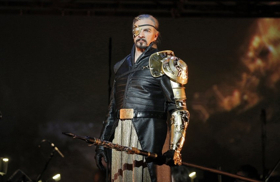Review: Arizona Opera Presents DAS RHEINGOLD ~ Grandeur And Majesty In Scale And Scope

In mid-19th Century Europe, revolution was in the air ~ in politics (Marx), science (Darwin), philosophy (Schopenhauer), psychology (Kierkegaard) and the arts (Goethe). Amidst the swirl of change, Richard Wagner was reinventing and restructuring opera, creating an all-embracing art form (Gesamtkunstwerk) that integrated poetry, music and story into what became branded as music drama. His invention found its full expression in the epic tetralogy (The Ring cycle), Der Ring des Nibelungen. the preliminary chapter of which is DAS RHEINGOLD.
With equal flashes of imagination and innovation, Arizona Opera's production of DAS RHEINGOLD, under the visionary direction of Brian Staufenbiel, has added technology to this fusion of theatrical elements. The result is the creation of an engaging environment and an enthralling experience ~ reason enough, I daresay, to sit for two and a half uninterrupted hours and embrace the convolutions of plot and the intrigues of its mythical characters!
David Murakami's digital wizardry augments the composer's leitmotifs with spectacular projections that together capture the motion, moods and moments of the drama. Paramecium -like particles swirl in the ether morphing into the cogs and gears of industry; a mysterious giant eye peers out over the stage; a huge dragon emerges; waves roil and roll until they flow into the more tranquil waters of the river Rhine.
Staufenbiel echoes Wagner's emphasis on fusion with an intelligent and economical exploitation of space. True to Wagner's emphasis on the role of the orchestra, he gives it centrality on the main stage. Joseph Rescigno takes full advantage of the placement with a robust and muscular direction of the Arizona Opera Orchestra. The pit is reserved, at times for the Rhine Maidens, at times for the underworld of enslaved dwarves. And a bridge traverses the stage whereupon the gods declare their intentions and aspirations.
It is in this context ~ the merging of stagecraft and technology ~ that an exceptional cast fulfills its role and captures the intense struggle and tradeoffs between gods and men to secure powers greater than they have: Richard Paul Fink as Alberich, the unsightly and avaricious Nibelung dwarf who steals the Rhine gold from the protection of its guardian maidens and forges the ring that grants him power to rule the world; Mark Delavan as Wotan, the god of all gods, who craves the ring but requires it as ransom for his wife's sister Freia (Laura Wilde), held captive by the giants, Fasolt (Harold Wilson) and Fafner (Zachary James), the builders of Wotan's future home, Valhalla; Rodell Rosel as Loge, the god of fire, Wotan's counselor, and a mercurial trickster. These are rich and robust performances to which are added, most notably, those of Dana Beth Miller as Erda, Dennis Petersen as Mime, and Daveda Karanas as Fricka.
For Phoenicians, I wish I could say, go see DAS RHEINGOLD. But, I can't, because one weekend at Symphony Hall in Phoenix (April 6th through 8th) was the opportunity. However, I can say it is more than worth it to travel down to Tucson for its final performances on April 14th and 15th at Tucson Music Hall.
One final word: With DAS RHEINGOLD as the concluding program of its 2017-2018 Season, Arizona Opera continues its impressive repositioning as one of the premiere companies in the nation, with a remarkable capacity to make the art form ever more accessible and appreciated. Congratulations to all!
Image Courtesy of Minnesota Opera
Reader Reviews

Videos

